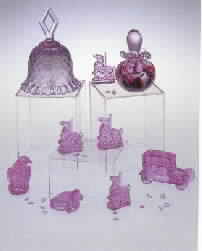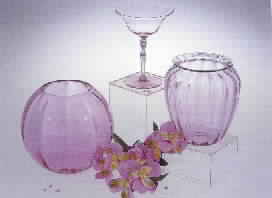 |
 |
 |
 |
|
|
|
 |
 |
 |
| Morgantown introduced its Alexandrite no later than January, 1930. It was only offered in a few items and no mention of the color can be found in Morgantown`s 1931 catalog. One of my references suggested that perhaps it was experimental. I have searched through two Morgantown books and several articles, and I have found only these items produced in Alexandrite: #7665 Laura stems, #7667 Georgian stems, #7594 Exeter stems and #7639 footed finger bowl. All of these are extremely difficult to find. |
|
| I have included an advertisement from the June, 1930 , Good Housekeeping magazine. An excerpt reads, " When you see this new Alexandrite glassware by Heisey, you wonder at its soft, elusive radiance." That is a beautiful description, and now we know that Alexandrite was being produced from at least June, 1930. In the seven books and dozens of newsletters that I have regarding Heisey, I have found several start and ending dates shown for the production period of Alexandrite. What continues to keep pieces in demand and prices high is its beauty and its "soft, elusive radiance." Heisey made the most Alexandrite in its #1401 Empress pattern, but the color was used in many other lines. A tall candelabrum, such as #301 Old Williamsburg, is a joy to see. The following lines have pieces made in Alexandrite (there are others): #4027 Christos, #301 Old Williamsburg, #1306 Comet Leaf, #3381 Creole, #1401 Empress, #4045 Ball vase, #1445 Grape Cluster candlesticks, #3390 Carcassonne and #134 Trident. A pair of two-light #134 Trident candlesticks sold recently for $800. Heisey discontinued most of its Alexandrite production around the mid-thirties. |
| |
| I found references to Steuben`s Wisteria having been in production as early as 1928. It was certainly popular. In the December 1932 catalog alone, I counted 45 lines which were available in Wisteria. Steuben`s glass was not mass-market oriented; therefore, there were no vast amounts of glass made in any line, pattern or color. I haven`t listed all those line numbers, since Steuben`s Wisteria is infrequently available for purchase. |
| Photo #7: |
| (1) Steuben #7434 vase. 6 ¼". $600. |
| (2) Elusive Morgantown #7677 Georgian champagne stem. 6". |
| (3) Heisey #4045 Ball vase. 7". $650. |
|
|
|
 |
|
 |
 |
 |
|
|
|
 |
 |
 |
| Lotton Art Glass, which produces some of the most beautiful glass in the country, designs and executes incredible bowls, vases and sculptures using neodymium glass. The company has used the terms Neo-blue and Neodymium glass for its pieces. Some pieces are tall swirling sculptural designs encased in Neodymium glass. The company makes an adorable line of mini-perfumes with florals also encased in Neodymium glass. Charles Lotton, the founder, has been delighting collectors with his art glass and his Multi Flora design for almost 30 years. |
| Photo #8 shows one of the mini-perfume bottles and Photo #13 shows a Charles Lotton Multi Flora neodymium glass bowl. It is 11" in diameter. Charles made this piece for me this year. |
| |
| The world-renowned Dale Chihuly worked with neodymium glass in his famous "Chihuly Over Venice" series of chandelier installations in Venice, Italy. The portfolio art print shown here is of a chandelier made in Nuutajarvi, Finland. It is inscribed by Chihuly "Neodymium Chandelier, Detail in the Woods, Nuutajarvi, Finland, Part I June 1995, Chihuly." Since the price of any Chihuly work is stratospheric, I do enjoy this print with the name of my favorite glass inscribed in his own hand. |
|
| Fenton produced a Wisteria in 1977 and 1978 which contained neodymium oxide. There were ten items offered in the color: 7" Threaded Diamond-optic basket, Knobby Bullseye candy box, 7" Threaded Diamond-optic vase, Colonial candy box, Tree-of-Life comport, Heart fairy light, 5 ½" and 7 ½" Swirl ashtrays, 6 ½" Threaded Diamond-optic bowl and Threaded Diamond-optic bell. Fenton`s Wisteria has only a subtle change of color, not the dramatic shift of the other companies` colors covered herein. A copy of a page from the January 1977 Fenton catalog, which features this glass, can be found on Page 100 of the book, "Fenton Glass, The Third Twenty-Five Years," by William Heacock. . . Both Mr. Bill Fenton and Mr. Frank Fenton were kind enough to speak with me by phone. Mr. Frank Fenton remembered the line and the neodymium oxide usage clearly. Speaking with him was a wonderful, educational experience for me. They are two fine gentlemen from a wonderful and successful company. In Photo #8 you will see the Threaded Diamond-optic bell. |
|
| Boyd makes small figural pieces and other items in its Alexandrite. A limited number of an item is pressed in a specific color, and then that item is not pressed again in that color. Boyd has made many items in its Alexandrite color. In Photo #8 there are seven of the Boyd minatures. |
| Photo #7, clockwise from upper left: |
| (1) Fenton, Threaded Diamond-optic Bell. 5 ½". $40. |
| (2) Boyd, Candy the Carousel Horse.2". $10. |
| (3) Lotton, mini-perfume w. floral design. 3". $125. |
| (4) Boyd, Taxi. 2 ½". $15. |
| (5) Boyd, carousel horse. |
| (6) Boyd, Jeremy Frog. 2". $10. |
| (7) Boyd, Bernie Eagle. 3". $10. |
| (8) & (9) (center) Boyd, carousel horses. |
|
 |
|

